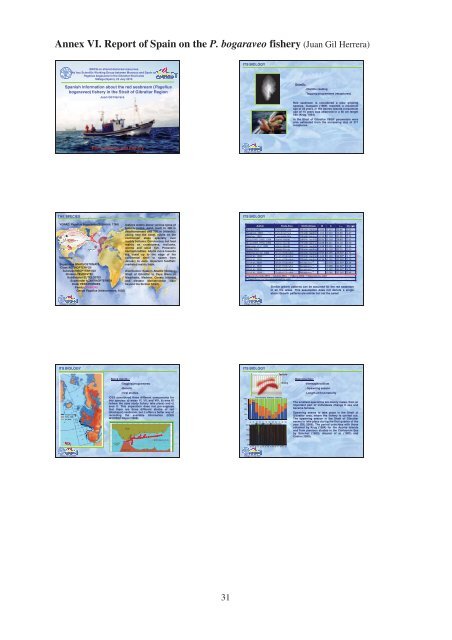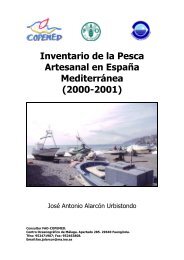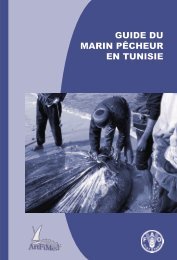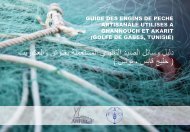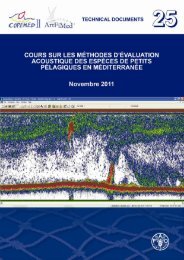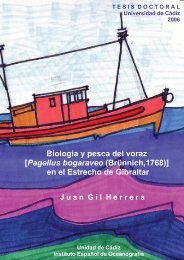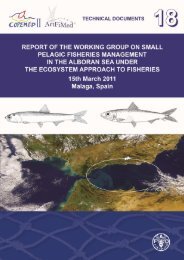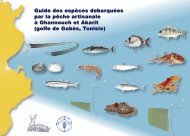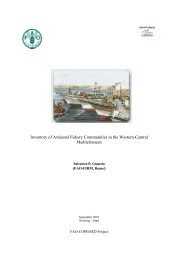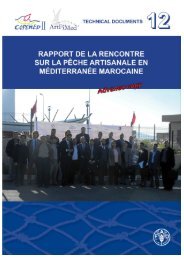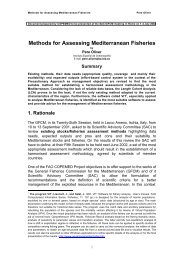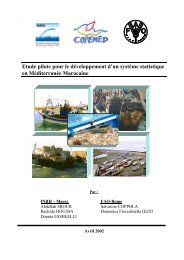Create successful ePaper yourself
Turn your PDF publications into a flip-book with our unique Google optimized e-Paper software.
j<br />
Annex VI. Report of Spain on <strong>the</strong> P. bogaraveo fishery (Juan Gil Herrera)<br />
SRWG on shared demersal resources<br />
Ad hoc Scientific Working Group between Morocco and Spain on<br />
Pagellus bogaraveo in <strong>the</strong> Gibraltar Strait area<br />
Málaga (Spain), 22 July 2010<br />
ITS BIOLOGY<br />
Spanish information about <strong>the</strong> red seabream (Pagellus<br />
bogaraveo) fishery in <strong>the</strong> Strait of Gibraltar Region<br />
Juan Gil Herrera<br />
Growth:<br />
-O<strong>to</strong>liths reading<br />
-Tagging programmes (recaptures)<br />
Red seabream is considered a slow growing<br />
species. Gueguen (1969) <strong>report</strong>ed a maximum<br />
age of 20 years. In <strong>the</strong> Azores Islands a maximum<br />
ageof15yearswasobservedina56cmlength<br />
fish (Krug, 1994).<br />
In <strong>the</strong> Strait of Gibraltar VBGF parameters were<br />
also estimated from <strong>the</strong> increasing size of 271<br />
recaptures.<br />
Part I: Biology and Fishery<br />
<br />
THE SPECIES<br />
VORAZ: Pagellus bogaraveo (Brünnich, 1768) Inshore waters above various types of<br />
bot<strong>to</strong>m (rocks, sand, mud) <strong>to</strong> 400 m<br />
(Mediterranean) and 700 m (Atlantic);<br />
young near <strong>the</strong> coast, adults on <strong>the</strong><br />
continental slope specially over<br />
muddy bot<strong>to</strong>ms. Omnivorous, but feed<br />
mainly on crustaceans, mollusks,<br />
worms and small fish. Protandric<br />
hermaphrodites. Adults move <strong>to</strong>wards<br />
<strong>the</strong> coast up <strong>to</strong> <strong>the</strong> edge of <strong>the</strong><br />
Taxonomy:<br />
continental shelf <strong>to</strong> spawn from<br />
January <strong>to</strong> June. Important foodfish:<br />
Superclass GNATHOSTOMATA<br />
marketed mainly fresh.<br />
Class ACTINOPTERYGII<br />
Subclass NEOPTTERYGII<br />
Distribution: Eastern Atlantic (Norway,<br />
Division TELEOSTEI<br />
Strait of Gibraltar <strong>to</strong> Cape Blanc in<br />
Subdivision EUTELOSTEI<br />
Mauritania, Madeira, Canary Islands)<br />
Superorder ACANTHOPTERYGII and western Mediterranean (rare<br />
Order PERCIFORMES<br />
beyond <strong>the</strong> Sicilian Strait).<br />
Family SPARIDAE<br />
Genus Pagellus (Valenciennes, 1830)<br />
ITS BIOLOGY<br />
∞ φ<br />
<br />
<br />
<br />
<br />
<br />
<br />
<br />
<br />
<br />
<br />
<br />
<br />
<br />
<br />
<br />
<br />
<br />
Similar growth patterns can be assumed for <strong>the</strong> red seabream<br />
in all <strong>the</strong> areas. This assumption does not denote a single<br />
s<strong>to</strong>ck: Growth patterns are similar but not <strong>the</strong> same!<br />
<br />
<br />
ITS BIOLOGY<br />
ITS BIOLOGY<br />
Testicle<br />
S<strong>to</strong>ck identity:<br />
Reproduction:<br />
-Tagging programmes<br />
Ovary<br />
-Hermaphroditism<br />
-Genetic<br />
- Spawning season<br />
-Viral studies<br />
-Length at first maturity<br />
<br />
<br />
<br />
ICES considered three different components for<br />
this species: a) areas VI, VII, and VIII; b) area IX<br />
(where <strong>the</strong> case study fishery take place) and c)<br />
area X. This separation does not pre-suppose<br />
that <strong>the</strong>re are three different s<strong>to</strong>cks of red<br />
(blackspot) seabream, but it offers a better way of<br />
recording <strong>the</strong> available information (ICES<br />
WGDEEP Report 2008).<br />
SPAIN<br />
Hermafroditas Hembras Machos<br />
100%<br />
75%<br />
50%<br />
25%<br />
0%<br />
I II III IV V VI VII VIII IX X XI XII<br />
Machos Hembras Hermafroditas<br />
100%<br />
75%<br />
50%<br />
The smallest specimina are mainly males, <strong>the</strong>n an<br />
important part of individuals change it sex and<br />
became females.<br />
Spawning seems <strong>to</strong> take place in <strong>the</strong> Strait of<br />
Gibraltar area, where <strong>the</strong> fishery is carried out.<br />
The spawning season in <strong>the</strong> Strait of Gibraltar<br />
seems <strong>to</strong> take place during <strong>the</strong> first quarter of <strong>the</strong><br />
year (Gil, 2006). The period coincides with those<br />
obtained by Krug (1994) for <strong>the</strong> Azores Islands<br />
and from previous studies in <strong>the</strong> Cantabrian Sea<br />
by Sánchez (1983), Alcaraz et al. (1987) and<br />
Castro (1990).<br />
MEDITERRANEAN SEA<br />
25%<br />
ATLANTIC<br />
OCEAN<br />
0%<br />
25 27 29 31 33 35 37 39 41 43 45 47 49 51 53<br />
MOROCCO<br />
<br />
<br />
31


